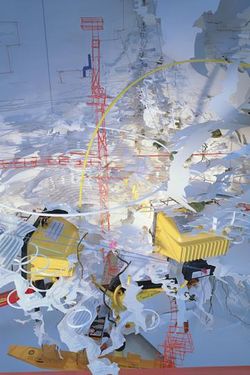From Columbia.edu:
 Sarah Sze, Professor of Visual Arts at Columbia University School of the Arts, has been chosen to represent the United States at La Biennale di Venezia in 2013. Her work will be presented by Holly Block and the Bronx Museum of the Arts in the 55th International Art Exhibition. The work, titled Triple Point, will inhabit and directly comment upon the architecture of the 1930s Palladian-style structure of the U.S. Pavilion designed by famed architects William Adams Delano and Chester Holmes Aldrich, appearing to modify the building’s structure without actual physical change. “Sarah Sze is a perfect choice to deftly engage the U. S. Pavilion,” said Carol Becker, Dean of Faculty. “Her site-specific work is dramatic, playful, seductive and filled with ideas about the fragility and durability of contemporary life. She’s a fantastic artist, a great teacher and we are proud to have her on our faculty.”
Sarah Sze, Professor of Visual Arts at Columbia University School of the Arts, has been chosen to represent the United States at La Biennale di Venezia in 2013. Her work will be presented by Holly Block and the Bronx Museum of the Arts in the 55th International Art Exhibition. The work, titled Triple Point, will inhabit and directly comment upon the architecture of the 1930s Palladian-style structure of the U.S. Pavilion designed by famed architects William Adams Delano and Chester Holmes Aldrich, appearing to modify the building’s structure without actual physical change. “Sarah Sze is a perfect choice to deftly engage the U. S. Pavilion,” said Carol Becker, Dean of Faculty. “Her site-specific work is dramatic, playful, seductive and filled with ideas about the fragility and durability of contemporary life. She’s a fantastic artist, a great teacher and we are proud to have her on our faculty.”
Sze has won acclaim for her minutely detailed, accumulative installations, in which everyday items such as coffee cups, plastic bottles and electrical fans become vital objects that defy the boundaries between the throwaway and the precious, the mundane and the monumental. Sze has always been known for work that challenges viewers to experience space in unexpected ways, and her installation at the U.S. Pavilion at the Biennale promises to do the same on a grand scale. Sze will create a sequence of constructed environments that will activate the Pavilion’s architecture and extend beyond the building and into the courtyard, blurring the perceptual boundaries between the site’s interior and exterior.
In conjunction with the installation, the Bronx Museum of the Arts will create a video stream documenting Sze’s process of conceiving, fabricating, and installing the piece. This will extend the project’s reach beyond the Giardini and link Sze with a worldwide audience.
More here.
